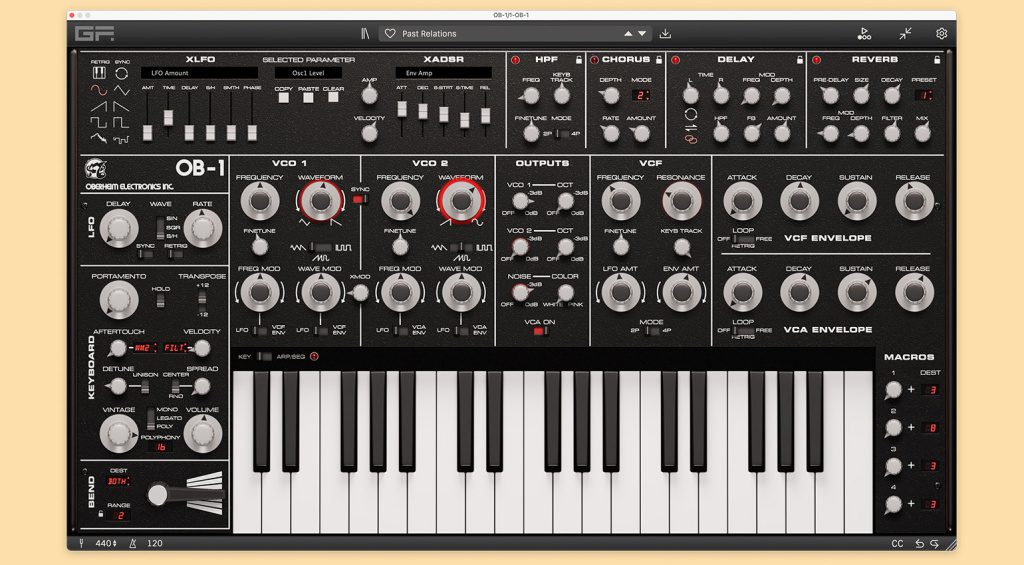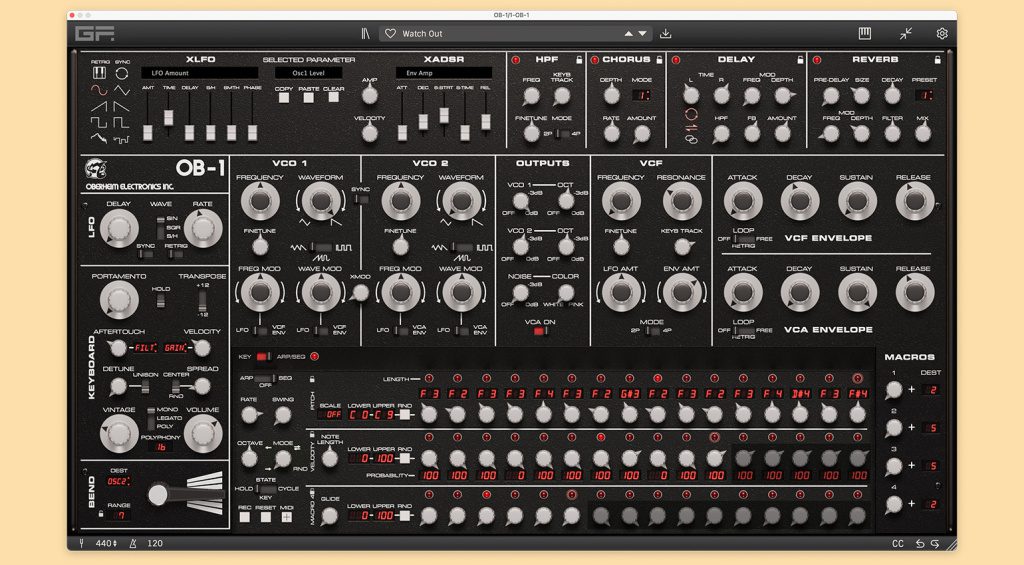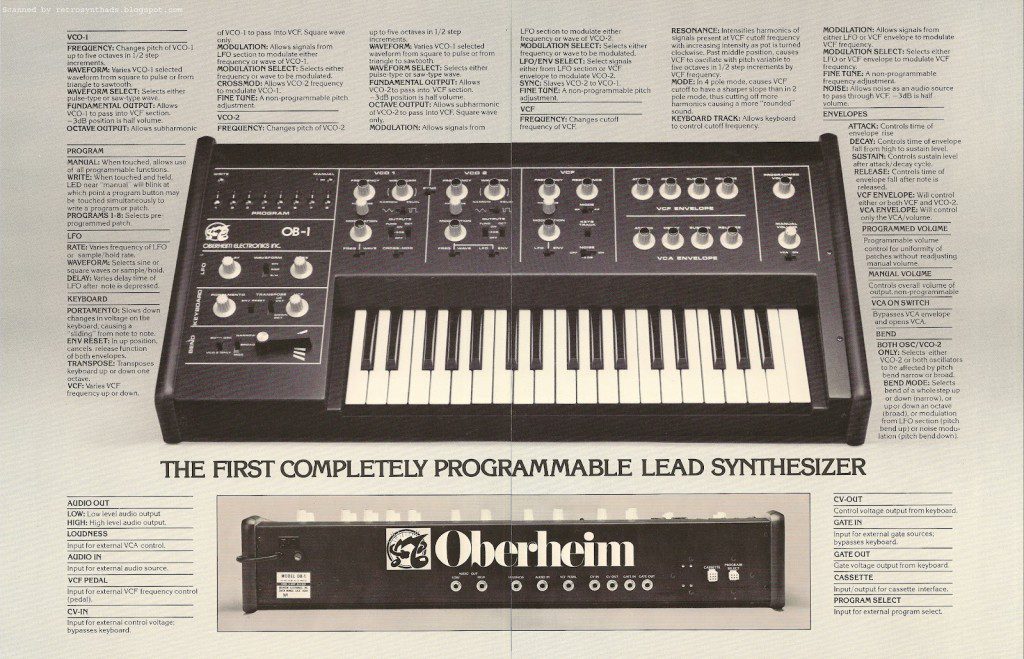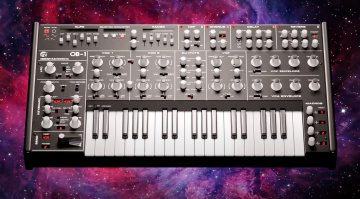As Tom Oberheim celebrates his 88th birthday, GForce Software continues its officially endorsed software recreations with the classic and much revered Oberheim OB-1.
What a time to be an Oberheim fan, eh? Tom Oberheim has been rightfully reinstated as one of the greatest living synth pioneers of all time and we are spoiled rotten with our choice of instruments bearing his name.
GForce Software, long and unashamed fans of both the man and his machines, now give us the classic OB-1 mono synth, replicated and reimagined for the 21st century. Now we can all experience this rare fan-favourite in an affordable and accessible way.
The Oberheim OB-1 – Big Things Start in Small Ways
Tom Oberheim began his commercial life making electronic effects units in 1970. it wasn’t until 1974 that he created the now legendary Synthesizer Expander Module (SEM). This was originally designed to accompany his digital sequencer, the DS-2A. A year later, he took four of these monophonic synth units, added a keyboard and, in later versions, a polyphonic programmer.
This beast, the world’s first commercially available polyphonic synth, soon grew into the eight voice, simply achieved by adding four more SEM modules. It was big, expensive but sounded like nothing else. The way Tom “solved” the polyphonic issue was to simply use a SEM for each voice and allow the digitally scanning keyboard to trigger the next available unit.
But technology was advancing and everything was getting smaller and cheaper. A year after releasing the biggest Eight Voice yet, with a dual manual keyboard, in 1976, Oberheim went in the opposite direction, size-wise, and gave us the OB-1. This synth’s design was to be the origin of what would turn out to be their best-known range of synthesizers.
Building On The Past, Looking To The Future
Whilst taking a lot of inspiration from the SEM, the OB-1 added ADSR envelopes, a switchable 2-pole/4-pole filter and a noise generator. One of its most innovative features was its ability to store presets. Eight patches could be stored under each one of the touch-sensitive metal buttons. However, this feature was still a bit quirky as it didn’t store every single parameter setting, leaving some to still require manual adjustment.
What the OB-1 delivered was both a sonic and physical origin to the bigger, polyphonic OB-prefixed synths that dominated the market in the early 1980s. And now we can experience the splendour of the OB-1 in software form with GForce Software’s officially endorsed plugin.
The GForce Software Oberheim OB-1
For as long as I have known Dave Spiers and Chris Macleod, founders of GForce Software (and it is a looong time!), they have always been huge fans of Oberheim, Dave in particular. His reverence for Tom and his sonic achievements is palpable. So when they got the stamp of approval from Tom on their OB-E, it was a very proud moment for them.

This association continues here and the GForce OB-1 takes that original, classic paradigm and expands upon it in numerous useful ways. Every original aspect of the OB-1 is here, detailed in a high-resolution user interface.
It would be remiss of GForce not to bring their extensive knowledge and experience to bear on the OB-1 by adding numerous new features to it. But in doing so, they never detract from or disguise the wonderful tone this instrument creates.
Oberheim OB-1 in 2024
Obviously, the OB-1 is now polyphonic with up to 16 voices available, as well as poly aftertouch. There is now also a monophonic Unison mode. This in itself is worth the price of entry alone. I swear my cat lost one of its lives when I switched the Unison mode on and played a note! Something this small does not deserve to sound so huge.
Each of the oscillators has an additional waveform as well as waveshape modulation. The levels of these and of the noise generator and sub oscillator can now be discretely controlled. Both the VCF and VCA ADSR envelopes are either free-running, loopable or retriggerable.
Once again, GForce have added their X-Modifier which allows for almost total modulation control over most parameters. They’ve also added a new high-pass filter, allowing for more precise frequency control. And of course, there are the now-obligatory effects which, as I have mentioned before, are both simple, powerful and effective.
There is also a built-in step sequencer which is so much fun to use. There are 16 steps of pitch, velocity and glide and each of these rows has a randomisation button, encouraging you to look for happy accidents. There is also an arpeggiator function and a handy swing function too.

Topping the functional features out are the four macro controls which allow you to combine multiple parameter changes into any one of four macro controls. The preset browser continues the trend of all new and revamped GForce instruments with its simple layout and powerful search features. In here you can fond over 300 presets from the likes of Dave Spiers himself, as well as Jamie Morden of GEOsynths, Jogging House, Plug Hugger, Jordan Passmore and many others.
Oberheim OB-1 from GForce Software – My Thoughts
The original OB-1 gets lost sometimes in synth history. It always seems to be overshadowed by the likes of the Minimoog, Odyssey and MS-20. It seems odd, because it can do most of what those others can do and had the added bonus of being able to store your creations.
Maybe it was because it came later than the rest or that it wasn’t produced in huge numbers. Whatever it was, it never truly got its moment in the limelight. But that can all change now with the GForce version. With the level of passion and skill applied to it, the software incarnation of the OB-1 retains all that was unique about the hardware and enhances it to live in our technologically more advanced world.
GForce have clearly found a formula and are unsurprisingly sticking to it. When they released the SEM plugin, some questioned whether it was worth it, given that we had eight of them in OB-E. Similarly, some might question the validity of having a polyphonic OB-1 when you can have the OB-X plugin. The simple answer is yes, it is absolutely worth it. Whilst under the hood, there may be some similarities, the very design of the instrument makes it unique and worthy of consideration.
In Conclusion
I am so happy to have this in my sonic arsenal as it really does sound like nothing else when you dig in. In fact, if Tom and his friends at Sequential are reading this, I would happily pay for a new hardware recreation! But for now, the GForce plugin knocks this out of the park and maintains a clear winning streak from this most brilliant of plugin developers.
GForce Software Oberheim OB-1 is available to buy now for an introductory price of $49.99 + VAT, rising to £99.99 after that. It is available in AU/VST/VST3/AAX formats and standalone for both Windows 7/macOS 10.13 or above.






